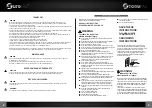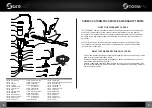
5
4
This chapter lists the common problems linked with the use of the appliance. If you are unable to
resolve the problems with the information given here, please contact your nearest assistance centre.
Low Suction or Poor Pickup
Possible causes
1. Disposable dust bag is full
2. Wand is not properly installed
3. Tool not working properly
4. Air path obstructed
Vacuum Motor is not working
Possible causes
1. Vacuum is not plugged in
2. Electrical outlet is not working
3. Motor thermal protector activated due to blockage
4. ON/OFF switch fault
5. Motor defective
Remedies
1. Dispose current disposable bag and replace with new
2. Secure wand properly to ensure no air leaks
3. Make sure tool is on the wand properly and tightly
4. Check for any air flow obstructions
Remedies
1. Check to make sure vacuum is plugged in properly
2. Check electrical source.
3. Allow cleaner to cool down, and check the vacuum ducts
and filters for blockage.
4. Contact an authorized service centre.
5. Contact an authorized service centre.
MAINTENANCE AND CARE
OPERATIONS
TROUBLE SHOOTING
1. Make sure the machine has been secured (see the section titled “SECURING THE MACHINE”).
2. Take the appliance to the designated place for emptying the tank.
3. Carry out the procedures described in the chapter “MAINTENANCE”.
4. Position the appliance on a flat surface in an enclosed place; there must be no objects near the
appliance that could either damage it, or be damaged through contact with it. If you decide to
hang the appliance on supports, make sure they are able to sustain its volume and weight.
THE END OF THE WORK
1. Release the two latches and lift off the lid to ensure that the
micro filter cloth bag and the disposable bag are inside. Once
checked replace the lid back and lock the latches.
2. Both the micro filter cloth bag and disposable bag, filter the air
while holding all debris. The micro filter cloth bag with its rubber
top provides the seal for the vacuum while also filtering the air.
Replace or empty each as necessary.
3. Make sure lid is locked on the vacuum. Take the vacuum hose
and push it into round opening on top of lid.
To change the filter bag:
1. Shut off power switch and unplug all cords from outlet
and vacuum.
2. Check disposable bag to see if it is full. Always change
disposable bag when full, discard and replace with a new one.
3. Do not reuse the disposable bag – this affects the filtration
of the backpack.
4. Always check the micro filter cloth bag each time when you
replace the disposable bag. Clean or change it as necessary.
NOTE: Very fine powders and substances may clog the cloth bag.
Please remember to empty bag often so that vacuum cleaner can
efficiently operate.
Power cord and storage:
5. Always unwind the extension cord completely before vacuuming.
6. Never stretch or pull cord tightly, this will damage the cord and
create a danger.
7. Always unplug vacuum from wall when not in use.
8. Always check condition of all electrical cords before use.
Never use cord if it is ripped or has a tear.
9. Unplug extension cord and wrap loosely when not in use.
10. When backpack vacuum is not in use, always store in a dry area
or place.
NOTE: Do not repair if you are not an authorized technician familiar with
the commercial backpack. Do not lubricate motor. It is equipped with
sealing bearings.
1. Make sure the machine has been secured (see the section titled “SECURING THE MACHINE”).
2. Remove the vacuum nozzle (1) from the hole in the cover (2) of the appliance turning it
anti-clockwise (Fig. 1) .
3. Remove the cover (2) of the vacuum tank (Fig. 2), releasing the hooks (3) on the side of the tank
itself (Fig. 3)
4. Remove the collection bag (4) from the tank (Fig.4).
5. Remove the fabric filler (5) from the appliance (Fig.5).
6. Clean the inside of the collection tank with a damp cloth.
7. Insert the fabric filter (5) in the tank (Fig.6).
8. Insert the collection bag (4) in the tank (Fig.7)
9. Place the cover (2) on the vacuum tank (Fig.8), using the hooks (3) on the side of the tank
itself (Fig.9)
10. Disconnect the vacuum hose (6) from the cover (2) (Fig.10).
11. Clean the inside of the vacuum with a jet of compressed air, if necessary removing any
obstructions.
12. Disconnect the cleaning accessory.
13. Clean the inside of the vacuum chamber of the accessory with compressed air, and if
necessary remove any obstructions.
MAINTENANCE
To dispose of the appliance, take it to a demolition centre or an authorised collection centre.
Before scrapping the machine, it is necessary to remove and separate out the
following materials, then send them to the appropriated collection centres in
accordance with the environmental hygiene regulations in force:
• Felt
• Electric and electronic parts*
• Plastic parts
• Metallic parts
(*) In particular, contact your local distributor when scrapping electric and
electronic parts.
DISPOSAL
ATTENTION:
Check the condition of the cloth filter if the filter surface area is particularly clogged
or if it is damaged replace it.
ATTENTION:
When inserting the fabric filter (5) in the tank, make sure that the gasket adheres
fully to the edge of the tank so that the vacuuming is not compromised.
ATTENTION:
When putting on the cover (2) make sure that the nozzle (6) is inserted correctly
into the hole on the collection bag (4) (Fig.8).
WARNING:
Before inserting the fabric filter (5) in the tank, wait until it is completely dry if it was
washed.
N.B. :
When using bags for collecting dust, made of fabric instead of paper, empty them and
clean them with a jet of air, check their condition and if necessary change them.
N.B. :
If the surface of the filler is extremely dirty, brush the filler with a normal soft brush to clean
it thoroughly, and if necessary wash it in water.
2
1
3
3
2
1
6
5
4
5
5
4
7
4
8
9
3
2
10
6
WARNING:
To reduce the risk of fire, electric
shock, or injury, turn power
OFF and disconnect plug from
electrical outlet before performing
maintenance or troubleshooting.
2.
1. Remove the cover (1) from the vacuum tank (Fig.1) using the hooks (2) on the side of the
tank itself (Fig.2).
2. Check the fabric fibre (3) is correctly positioned (Fig.3) and that the collection bag (4) is
correctly inserted inside it (Fig.4).
3. Fasten the cover (1) above the vacuum tank (Fig.5) locking it with the hooks (2) on the side
of the tank itself (Fig.6)
4. Insert the nozzle (5) on the vacuum hose into the hole on the cover of the vacuum tank (Fig.7).
5. Connect the vacuum hose (6) with the aluminum pipe (7) (8)
6. Select the most suitable attachment for the work to be carried out. Attach the attachment (8)
to the aluminum tube (7)
1, Switch on the machine by setting the main switch (1) to “I” (Fig.1).
PREPARING TO WORK
WORK
N.B. :
If the vacuuming capacity is excessive, shift the lever (3) on the vacuum hose handle (Fig.3)
while the accessory is in contact with the floor.























